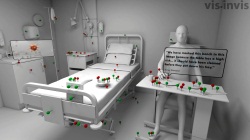4 July 2013
Research collaboration helps healthcare professionals visualise the invisible

pictures are of examples of the images produced during the project
Researchers from different disciplines and regions of Scotland have joined together in a new initiative to help healthcare
staff prevent and control healthcare associated infections.

With Norovirus, MRSA and C. difficile continuing to be a risk to patient recovery, and increasing resistance to antibiotics,
a new collaboration has been formed to study how staff think about these invisible threats and to look at ways to make them
seem more visible.
Led by experts from Robert Gordon University's Institute for Health and Welfare Research (IHWR) and the university's Institute
for Innovation Design and Sustainability (IDEAS), the 20-month 'Visinvis' project has involved nursing, art and design
researchers working with microbiologists, cleaners, nurses, estates staff and patient representatives.

In conjunction with colleagues at the University of Dundee, Glasgow School of Art, NHS Grampian, NHS Lanarkshire, NHS
Education for Scotland, and Health Protection Scotland, the team at RGU secured close to £100,000 from the Arts and Humanities
Research Council and the Scottish Funding Council to fund the research.
The project has worked with frontline staff and patients in clinical settings to better understand and map perceived
areas of risk. This was then compared with new data gathered in a hospital setting showing actual areas of risk. Dr Stephanie
Dancer, Consultant Microbiologist in NHS Lanarkshire, gathered data tracking which items within a ward were touched,
how often and by whom. Items in the study included patient notes, bedside locker and the bed frame.
Design professionals from Duncan of Jordanstone College of Art and Design (DJCAD), part of the University of Dundee,
and Glasgow School of Art then worked together to create a number of ways to help healthcare workers visualise the threat of
pathogens in clinical areas.
This included video clips which can provide the user with 'augmented reality' on-screen information as they view an area
through the screen. The aim is to go on in the future to develop a user-friendly system providing relevant information
in real-time that can be updated as conditions change in the setting.
Dr John McGhee, a visual design expert from DJCAD, said, 'This has been a very exciting project to work on which has
tapped into the creative skills of our team as well as our colleagues at Glasgow School of Art to develop dynamic
visualisations. The design work pulls together a lot of research data and could lead to fantastic visual aids to help
towards ensuring hospital wards and other care settings are kept clean.'
Project leader, Dr Colin Macduff from RGU, said, 'Although we know much about the germs or pathogens that cause these
infections, we know much less about how front-line staff and patients imagine them in clinical contexts, and how this
influences care giving and receipt.
Dr Dancer said, 'Many of the staff we worked with had a good basic grasp of where problem areas actually exist,
but there were some areas of difference, and there remains considerable scope for imaginative ways to help educate staff,
patients and visitors.'
The team is currently seeking further funding to build on what has been achieved. Dr Macduff added: 'The project has
brought together expertise from different fields, so that the knowledge of cleaners, clinicians and patients is valued
alongside knowledge from a range of academics. We hope to continue working together to research in more depth and to develop
creative educational interventions in this field.'
Further information about the project, including a summary report and short film are available at the project's new website
also launched today: www.visinvis.org.
Notes to editors
Research team
Dr Colin Macduff (Principal Investigator)
Reader, Institute for Health and Welfare Research/School of Nursing and Midwifery, Robert Gordon University, Aberdeen
c.macduff@rgu.ac.uk
Prof Alastair Macdonald (Senior Researcher)
School of Design, Glasgow School of Art
a.macdonald@gsa.ac.uk
Dr John McGhee (Co-Investigator)
Lecturer in Animation and Visualisation, Duncan of Jordanstone College of Art and Design, University of Dundee
j.mcghee@dundee.ac.uk
Dr Fiona Wood (Research Fellow)
Institute for Health and Welfare Research, Robert Gordon University, Aberdeen Tayside Children's Hospital, University of
Dundee, Dundee
f.k.wood@dundee.ac.uk
Dr David Loudon (Research Fellow)
School of Design, Glasgow School of Art
d.loudon@gsa.ac.uk
Charlie Hackett (Lecturer)
Institute for Innovation, Design and Sustainability Research/Gray's School of Art, Robert Gordon University, Aberdeen
c.hackett@rgu.ac.uk
Dylan Gauld (Research Assistant)
Duncan of Jordanstone College of Art and Design, University of Dundee
d.gauld@dundee.ac.uk
Dr Stephanie Dancer,
Consultant Microbiologist, Hairmyres Hospital, NHS Lanarkshire
Stephanie.Dancer@lanarkshire.scot.nhs.uk
Dr Anne Marie Karcher,
Consultant & Infection Prevention and Control Doctor, NHS Grampian
annemarie.karcher@nhs.net
For media enquiries contact:
Grant Hill
Press Officer
University of Dundee
Nethergate, Dundee, DD1 4HN
TEL: 01382 384768
E-MAIL: g.hill@dundee.ac.uk
MOBILE: 07854 953277 |

